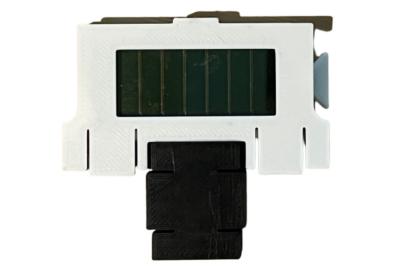Solaires Entreprises Inc. is a Canadian solar energy startup based in Victoria, BC., who has developed perovskite materials and photovoltaic (PV) modules, designed for integration into IoT devices, small consumer electronics, and smart gadgets. Powered by indoor light, the cells are extremely efficient, modular, and are configurable to suit the application.
Dr. Sahar Sam is Solaires Chief Science Officer, and she was kind enough to answer a few questions we had about Soliares. Dr. Sam holds a B.Sc. and an M.Sc. in Materials Science and Engineering from Shiraz University and a Ph.D. in Mechanical Engineering from the University of Victoria.
Hello Dr. Sam! We'll be happy to get a short introduction to Solaires, the technology, and products.
Founded in 2020 in Victoria, BC, Solaires Entreprises Inc is at the forefront of the next generation of photovoltaics, targeted for both outdoor light and indoor light, by harnessing the promise of perovskites. Our perovskite photovoltaics are light, thin and made of readily available and low cost materials.
The core innovations of Solaires come from our Solar InkTM and PVModules. Compared to our competition in the perovskite space, our Solar InkTM has an industry leading shelf stability, with each formulation exceeding 30 days. This stability allows us to ship our Solar InkTM worldwide, and produce the ink at economic scales. Meanwhile, our PVModules are small modules designed for the indoor photovoltaic (IPV) market. PVModules use our Solar InkTM along with our innovative manufacturing processes to produce devices with power densities exceeding 0.15 mW cm-2 under 1000 lux light.
We understand your main product is the Perovskite Ink. Can you detail what is the process of using this ink in the production of perovskite panels?
Solar InkTM is the heart of Solaires. The ink is manufactured in ambient conditions using low-cost precursors and environmentally friendly solvents. Perovskite inks are the light-absorbing core of a perovskite solar cell. To make our PVmodule Solar ink is deposited on flexible and rigid substrates using scalable methods like slot-die coating and blade coating, and sandwiched between conductive layers which transmit charge-pairs generated in the perovskite layer as it absorbs light.
What kind of performance can companies expect to achieve with your perovskite inks?
Our Solar InkTM based products produce devices which can exceed 20% efficiency in sunlight and exceed 40% with indoor light. These values are generally ~3x more efficient than commercial thin film photovoltaics coming from the dye-sensitised solar cell and organic photovoltaic space. And these values are just the start as we are continuously improving our products from Solar InkTM to PVModules, and beyond.
Can you detail any market/customer traction with the perovskite inks?
We have sent our perovskite inks to more than 25 customers spread over more than half a dozen countries around the world and have two distributors in Korea and Japan. We have largely targeted Solar InkTM to research centres (academic, industrial, and governmental) who incorporate it in their research and development projects, with an eye towards building relationships and partnerships for commercial production.
When do you expect the first commercial perovskite solar panel to arrive, based on your inks?
We are going to market with our PVmodules for indoor application in 2024. Our next step is to target the outdoor application and we expect to start producing our solar panels, designed to provide grid-scale power, in the next 2-4 years, and are actively developing these products today. We are also selling our Solar InkTM to big organisations which we can not disclose their names and they are planning to go to market using our solar ink in the next 5 to 10 years. We are excited to see what our Solar InkTM customers are developing to see what innovative designs they can produce with our Solar InkTM.
Recently Solaries started to offer perovskite solar modules, can you tell us more about the performance and intended applications of these modules?
Solaires has recently launched photovoltaic modules that can power IoT devices with outdoor and indoor light, to IoT device manufacturers who need a reliable, efficient, and wireless solution to power the devices they offer. Those in the industry have yet to be able to scale to a mass product and are also limited to applications that the world nowadays demands. To put the power of our PVModules into context, as an internal demonstration of our PVModule, we have repurposed a Logitech K750 wireless keyboard. The K750 keyboard is sold with integrated DSSC photovoltaic modules to power the keyboard. We observed a threefold increase in power output from our PVModules compared to the DSSCs sold in the device! By incorporating our Solar InkTM and modules, manufacturers can integrate photovoltaic energy generation into their products such as; solar-powered smart locks, scales, IoT devices, wireless keyboards, headphones, and even emergency LED flashlights.
Do you see Solaries becoming a solar panel maker, or is the module a product that mainly aims to accelerate adoption and acceptance of your perovskite inks?
We absolutely expect to develop solar panels in the next few years. One of the biggest benefits of our uniquely stable Solar InkTM is that when we licence our solar panel manufacturing process to external manufacturers, we will sell our Solar InkTM to licensees.
Many believe that the first perovskite solar applications will be in tandem panels, do you agree with that?
We are actively keeping an eye on the development of tandem technologies, and they have a lot of promise to provide solar-industry leading power conversion efficiencies. However, we are skeptical about the environmental benefits of tandem silicon-perovskite panels, which maintain most of the GHG and recycling-based downsides as traditional PVs. We are very excited about tandem perovskite-perovskite panels, and we may be joining the market as demand for tandem tuned Solar InkTM in the near future.
How do you see the perovskite market in 5 years? What role will Solaries make?
As IPV (Indoor photovoltaic) matures we expect the perovskite IPV market to grow in the next five years as we, as well as some of our colleagues in the market, are commercialising and scaling up products today. The lightweight and highly efficient nature of perovskite modules gives our field a huge leg up in the market, and we expect perovskites will be the IPV leaders within 5 years. Excitingly, we expect that the success of products like PVModules will drive innovation and investment in perovskite solar cells, leading to demonstration sites across the world.
Thank you Dr. Sam! Good luck to both you and Solaires!

